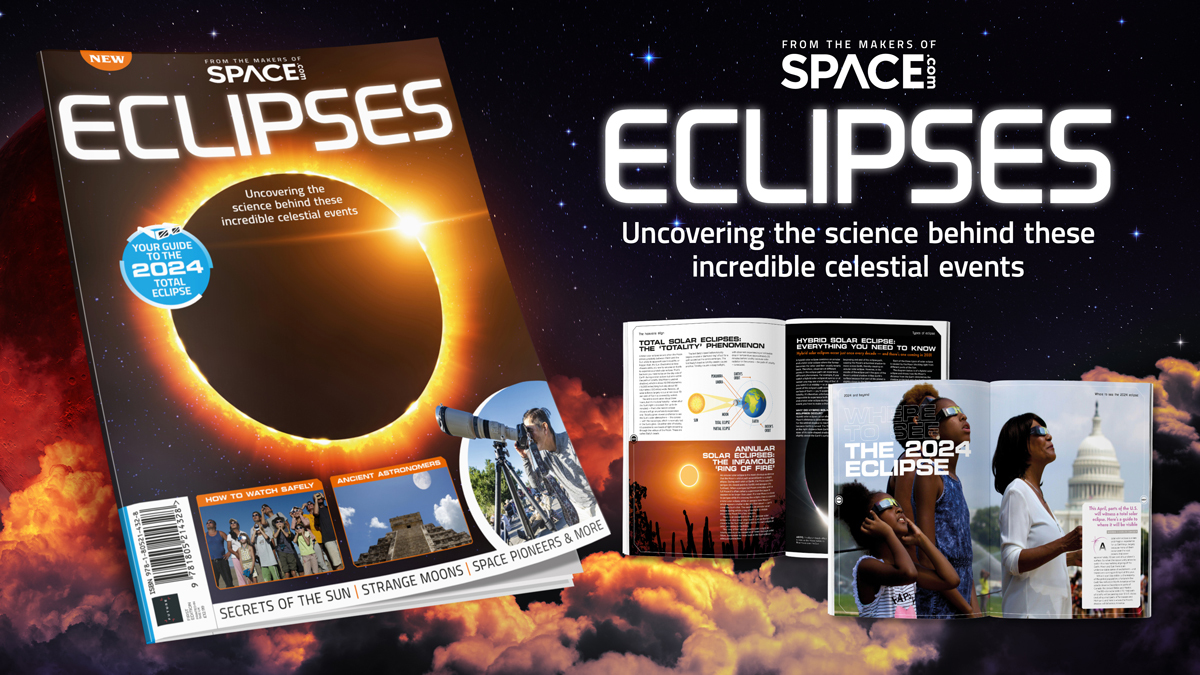Get ready for the 2024 total solar eclipse with Space.com with our 'Eclipses' bookazine
Everything you need to know about this year's most exciting astronomical event.

Space.com has come to print with a special magazine that guides you through all the information you will need to safely view and enjoy the most exciting astronomical event of 2024: a total solar eclipse that will sweep across the United States on April 8. It's on sale now, and you can buy it here through Magazines Direct.
The 2024 total solar eclipse will appear differently from various regions in which it is visible, only appearing as a total eclipse in some states. Other areas outside what's known as the "path of totality" will be able to see a partial solar eclipse.
All About Space Eclipses bookazine: $26.99
This special All About Space edition is packed with information about solar eclipses, including the April 8, 2024 total solar eclipse that will cross much of North America. Inside you will find everything you ever wanted to know about these rare celestial alignments, tour the surface of the moon, examine the depths of the sun and meet pioneers who dedicate their lives to enhancing our understanding of the stars.
One feature in the magazine, dubbed the "2024 and Beyond" section, explains what different states in the U.S. will experience, how much of the moon will cover the solar disk from each place, and what time you can expect the sun to darken depending on your location.
Related: What's the difference between a total and annular solar eclipse?
Addressing the next thing any budding eclipse watcher will need to know, another article in the "2024 and Beyond" section explains what kind of equipment eclipse-watchers can use to view the event safely. These pieces of kit run from relatively inexpensive Sun Projector Kits, priced at $23, and Solar Eclipse Glasses, priced at $3.80, to more expensive Solar Telescopes coming in at $1,083 — accounting for all levels of interest and desired investment. Plus, for those not looking to make a financial investment, the Space.com special details how to adapt an existing telescope to make safe lunar and solar observations.
As the buzz around this forthcoming solar eclipse suggests, these astronomical events have been big deals throughout the history of humanity. Celebrating how different cultures have explained and accounted for eclipses is thus outlined in the "Shadow of History" section of the Space.com special.
Of course, the eclipse's key players are the moon and the sun, so no good eclipse special would neglect to include stories loaded to the brim with details about the most important celestial bodies in our skies. Space.com always goes above and beyond, so the special also features articles about some of the different ways the sun, the Earth, and the moon can align to create different types of eclipses; it also details some of the curious moons that orbit solar system planets other than Earth.
Breaking space news, the latest updates on rocket launches, skywatching events and more!
Read on for a look at some of the other features in the Space.com special.
15 Facts You Never Knew About Eclipses
We can't give them all away here, but the Space.com special lays out stunning facts about eclipses, what causes them, how they progress and what advantages the dark skies they provide can have for astronomers looking to see things ordinarily invisible during the day.
How the Solar Eclipse Impacts Mother Nature
Humans are not the only species that will experience the darkening of the sun during the eclipse, and other life forms on Earth are much more attuned to their environments and surroundings. With the sun playing an important role in regulating the life cycle of plants and animals, Tia Ghose takes a look at some of the natural phenomena that could happen during the eclipse, such as flowers spontaneously closing their petals and thousands of salmon washing ashore.
How do Flat Earthers Explain the Eclipse?
Not everyone accepts that the Earth is a sphere that rotates around the sun with its own orbiting sphere, the moon. Hanneke Weitering goes down the rabbit hole to delve into the world of flat-earthers and "round-Earth deniers" to explore how the eclipse is explained by people who don’t accept the scientific facts surrounding our planet and its place in the wider solar system.
Who knows, if you get a flat-earth friend a copy of the Space.com Eclipse 2024 special, you may be the one to change their mind!
All About Space Eclipses bookazine: $26.99
This special All About Space edition is packed with information about solar eclipses, including the April 8, 2024 total solar eclipse that will cross much of North America. Inside you will find everything you ever wanted to know about these rare celestial alignments, tour the surface of the moon, examine the depths of the sun and meet pioneers who dedicate their lives to enhancing our understanding of the stars.
Join our Space Forums to keep talking space on the latest missions, night sky and more! And if you have a news tip, correction or comment, let us know at: community@space.com.

Robert Lea is a science journalist in the U.K. whose articles have been published in Physics World, New Scientist, Astronomy Magazine, All About Space, Newsweek and ZME Science. He also writes about science communication for Elsevier and the European Journal of Physics. Rob holds a bachelor of science degree in physics and astronomy from the U.K.’s Open University. Follow him on Twitter @sciencef1rst.

